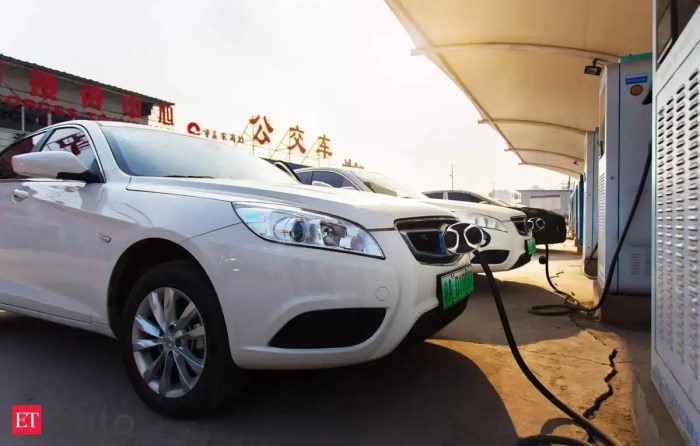Volkswagen’s commitment to electric mobility is undeniable. A key vehicle in their early electrification strategy was the e-Golf, a battery electric vehicle (BEV) based on the popular Golf hatchback. This article delves into the e-Golf’s significance, its specifications, its impact on the market, and its role in paving the way for Volkswagen’s broader EV lineup. We will explore its strengths and weaknesses, analyzing its contribution to Volkswagen’s overall electric vehicle (EV) strategy and its place within the broader context of the automotive industry’s transition to sustainable transportation.

Source: etb2bimg.com
The e-Golf: Specifications and Features
The e-Golf, produced from 2014 to 2020, represented Volkswagen’s first serious foray into the mass-market electric vehicle segment. While not the first electric car from the brand, it was a far more significant model, offering a more refined and practical package than its predecessors. Key specifications varied slightly across model years, but generally included:
- Battery Capacity: Initially around 24.2 kWh, later models boasted a larger 35.8 kWh battery, significantly extending its range.
- Range: The range improved substantially over its lifespan, going from approximately 118 miles (190 km) on the smaller battery to around 125-130 miles (201-209 km) on the larger battery. Real-world range, however, was often lower depending on driving conditions and climate.
- Motor Power: The e-Golf featured an electric motor providing respectable power for its class, sufficient for city driving and comfortable highway cruising.
- Charging: Supported both AC (Level 1 and Level 2) and DC fast charging, although DC fast charging speeds were not as high as some competitors.
- Technology: The e-Golf incorporated various technological features, including infotainment systems, driver-assistance technologies, and regenerative braking.
Design and Performance
Visually, the e-Golf closely resembled its gasoline-powered counterpart, the Golf, a deliberate design choice to make the transition to electric vehicles less daunting for consumers. The performance was smooth and quiet, a hallmark of electric motors, offering a pleasant driving experience. While not a sports car, it provided adequate acceleration for daily driving needs. The handling, inherited from the Golf platform, was generally praised for its balance and stability.
The e-Golf’s Role in Volkswagen’s EV Strategy
The e-Golf served as a crucial stepping stone in Volkswagen’s ambitious electrification plan. It allowed the company to:
- Gain Experience: Developing and manufacturing the e-Golf provided invaluable experience in battery technology, electric motor integration, charging infrastructure, and the overall logistics of producing and selling electric vehicles.
- Test Market Demand: The e-Golf helped gauge consumer interest and acceptance of electric vehicles, providing crucial data to inform future EV development.
- Develop Infrastructure: The introduction of the e-Golf prompted investment in charging infrastructure, both within Volkswagen’s own network and through partnerships with external providers.
- Build Brand Awareness: The e-Golf increased public awareness of Volkswagen’s commitment to electric mobility, positioning the company as a serious player in the emerging EV market.
Lessons Learned and Future Implications
While the e-Golf had its limitations, particularly in terms of range compared to later EVs, its development and sales provided critical lessons for Volkswagen. These learnings directly influenced the design and development of subsequent models like the ID.3 and ID.4, which benefited from improved battery technology, longer ranges, and more advanced features. The e-Golf’s relatively modest success, however, highlighted the need for more competitive pricing and longer ranges to capture a larger share of the EV market.
Comparison with Competitors
The e-Golf competed with other compact electric vehicles during its production run, including models like the Nissan Leaf, Chevrolet Bolt, and BMW i3. Compared to these competitors, the e-Golf offered a familiar and comfortable driving experience thanks to its Golf-based platform. However, its range and charging speed were often less impressive than some rivals, particularly the Chevrolet Bolt. The e-Golf’s strengths lay in its build quality, reliability, and the established reputation of the Volkswagen brand.
The e-Golf’s Legacy
Despite being discontinued, the e-Golf holds a significant place in Volkswagen’s history and the broader EV landscape. It represented a crucial learning experience, paving the way for the company’s more ambitious and successful ID. family of electric vehicles. The e-Golf’s contribution lies not only in its sales figures but also in the valuable knowledge and experience it provided, accelerating Volkswagen’s transition towards a fully electric future.
Its legacy is one of a stepping stone, a necessary precursor to a more advanced and competitive electric vehicle lineup.
Frequently Asked Questions (FAQ)
- What is the range of the VW e-Golf? The range varied depending on the battery size and model year, ranging from approximately 118 miles (190 km) to around 130 miles (209 km).
- How long does it take to charge the VW e-Golf? Charging times depend on the charging method. Level 1 charging is slow, while Level 2 charging is faster, and DC fast charging is the quickest option, though still significantly longer than refueling a gasoline car.
- Is the VW e-Golf still available for purchase? No, the e-Golf has been discontinued.
- What are the advantages of the VW e-Golf? Advantages included its familiar design based on the popular Golf, its relatively comfortable ride, and the reliability associated with the Volkswagen brand.
- What are the disadvantages of the VW e-Golf? Disadvantages included its limited range compared to newer EVs and its relatively slower DC fast charging speed.
Conclusion
The VW e-Golf, while not a perfect electric vehicle, played a pivotal role in Volkswagen’s electric vehicle journey. It provided valuable lessons, laid the groundwork for future models, and helped shape the company’s broader strategy for electric mobility. Its legacy extends beyond its sales figures, representing a significant step in the automotive industry’s transition towards sustainable transportation. The knowledge gained from the e-Golf has undoubtedly contributed to the success of Volkswagen’s current and future EV offerings.
References
- Volkswagen Official Website
- Car and Driver (For reviews and comparisons)
- Edmunds (For specifications and pricing information)
Call to Action
Learn more about Volkswagen’s current electric vehicle lineup and discover the future of sustainable driving. Visit your local Volkswagen dealership or explore their website today!
FAQ Overview
What were the main criticisms of the VW e-Golf?
Common criticisms included its limited range compared to later EVs and a relatively high price point for its capabilities at the time of its release.
How did the e-Golf’s technology compare to its competitors at launch?

Source: faresin.com
At its launch, the e-Golf’s technology was competitive but not groundbreaking. It offered a solid performance level, but other manufacturers were already introducing EVs with longer ranges and faster charging capabilities.

Source: optimole.com
Did the e-Golf achieve its sales targets?
While the e-Golf contributed to Volkswagen’s EV market presence, its sales figures likely fell short of initial internal projections, a common challenge for early-generation electric vehicles.
What impact did the e-Golf have on Volkswagen’s brand image?
The e-Golf helped position Volkswagen as a serious contender in the EV market, enhancing its image as a forward-thinking automotive company committed to sustainable technologies.
